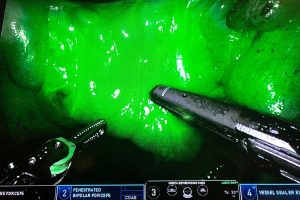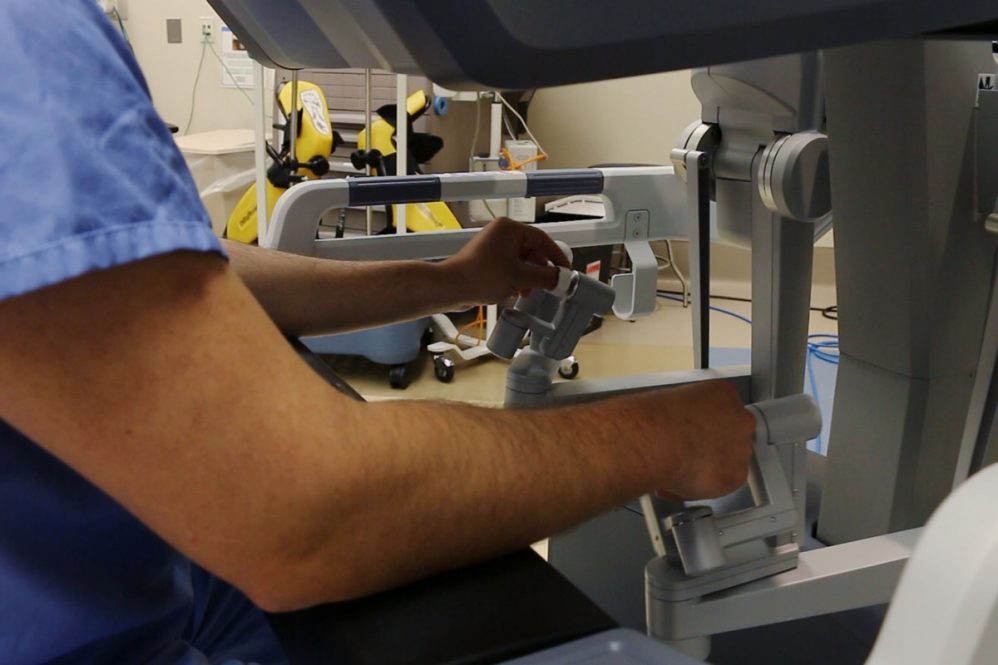The patient just feels better afterward. It makes a big difference. — Dr. Eric Girard

Traditional surgery and less-invasive laparoscopic surgery still have limitations when it comes to access, visibility, and precision. Robot-assisted surgery can overcome those obstacles — and in many cases, eliminate them — as Dr. Eric Girard, a colorectal surgeon at UConn Health, explains.
Why is robotic surgery becoming more prevalent?
If you’re looking for patients who want to have the fastest recovery, fastest return to work, and least amount of discomfort, one of the biggest things that we can offer them is a safe, effective procedure. In many cases we can reduce the patient’s stay to less than 24 hours, compared to three or four day with laparoscopic surgery or seven to 10 days with major open surgery, and the patient just feels better afterward. It makes a big difference.
For example?
We’re doing intracorporeal anastomosis, essentially putting together pieces of the bowel inside the abdomen. It leads to decreased ileus (slow down of the intestine), decreased anastomotic leaks (a potential complication from gastrointestinal surgery), shorter length of stay, and better recovery. People are home sooner, back to work sooner, and overall people are doing better.
To explain further, your bowel is most likely in a set position. When we have to take a segment out, we have to move and manipulate the bowel and get it freed up from its attachments so that it will then reach the other portion of the bowel when we put it back together. That act of putting the two ends back together is considered an anastomosis.
What are some other procedures for which robotics can make a big difference?
Colon cancer, rectal cancer, diverticulitis, inflammatory bowel disease, those are the big ones, for me at least. Anyone who has those problems, we can deal with them robotically. We’re removing cancerous tissue, or in the case of diverticulitis, we’re removing a segment of inflamed colon and putting it back together so people don’t get recurrent infections that cause them a lot of pain, time in the hospital, and potentially holes in their bowel that lead to ostomies and needing a bag.
When you have someone who’s got a lot of inflammation, whether it’s diverticulitis, people with fistulas, people with Crohn’s disease, things like that, you can really make a big difference robotically. When you have inflammation, the body tends to create this hard shell around whatever is the source of that inflammation. It makes it very difficult to find the right area to be between, let’s say two organs that are fused together. The robot helps me do that a lot better than laparoscopic surgery would. When you have a connection from the colon to the bladder, laparoscopically, most people will have to open it up and put a hand in there to feel that connection, whereas robotically I can manipulate the bladder. Instead of having just straight tools, I can go behind it with my wristed instruments and manipulate in ways that I can see that plane. And I have a third arm as opposed to just two hands.
What is it about the robotic approach that makes it advantageous?

I can see in 3D vision, I have the ability to use a fluorescent dye where I can ensure, with 100% surety, that there’s good blood flow to the area of my anastomosis. I have better visualization and I’m much more sure about exactly what I’m cutting when I’m cutting it.
When you have the robotic instrument, it literally is the same instrument as you would use in your hands, and whatever you would have at your fingertips, whatever surgical instrument your surgeon would be using, is exactly what the robot allows you to do. So if I wanted to have a scissor, I put the scissor in my tips and I can literally use it like it’s my fingers, or I’ll have a grasper and I’ll use it, and I can put it in any direction. It’s mimicking my movements, and it takes away any sort of tremor and it stabilizes the instruments. It can either make your movements very fine, and if you have bigger movements it actually scales them down to really fine movements. And you’ve got significant zoom effect, so you can really see right up close.
How does robotic surgery fit in to the concept of enhanced recovery after surgery (ERAS)?
It’s all part of getting patients back to normal sooner and back home sooner. Enhanced recovery after surgery has a lot to do with not taking them out of their everyday pattern. We don’t starve them; we let them eat as soon as they can. We try to get the patients up and walking right away. If they’re doing everything that they would otherwise be doing at home, then they can do it at home. We have people available 24/7; if they have any problems they can call and get help, but most people don’t. Once they check all the boxes that they’re doing well, they go home, and that gets people back to their families sooner.
We can do everything inside the body, so that means there’s less tissue damage in the process of bringing the bowel together. The goal is to put everything back together in a way that’s going to keep on working, and with as little a change, as little an interruption to your normal life.
Who else is doing this?
A lot of other services are using it similarly, GYN for their endometriosis for example. Our gynecologic oncologists are using it. We have thoracic surgeons who are taking sections of lung out with it. We have advanced hernia repairs with many of our general surgeons. Everyone is adopting this advanced minimally invasive approach because most people feel like they’re giving the patient a better opportunity to get out of the hospital sooner and to have a better recovery.
Learn more about surgery at UConn Health., or call 860-679-8080 to arrange a consultation.



